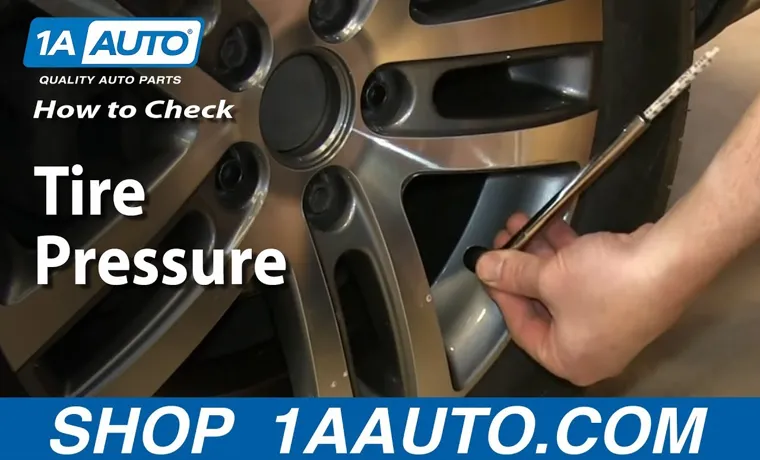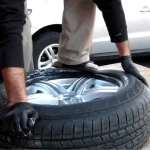If you’ve ever found yourself in a situation where you need to deflate a car tire, you might feel overwhelmed and unsure of where to start. Maybe you have a slow leak and need to lower the air pressure, or perhaps you’re planning to transport your car and need to reduce the tire pressure for safety reasons. Whatever your reason may be, deflating a car tire is a straightforward process when done correctly.
In this step-by-step guide, we’ll walk you through the process of deflating a car tire, making it easy for you to accomplish your task quickly and safely. So, let’s get started!
Table of Contents
What You Will Need
If you’re wondering how to deflate a car tire, there are a few things you’ll need to get started. First, you’ll need a tire pressure gauge so that you can accurately measure the air pressure in your tires. You’ll also need a valve stem removal tool so that you can easily remove the valve stem from your tire.
Another important item to have on hand is a tire deflation tool – this can be a simple handheld device or a more complex automatic system that will quickly and effectively deflate your tires. Finally, don’t forget to have a source of compressed air – whether it’s an air compressor or a can of compressed air – so that you can easily refill your tires once you’ve completed the deflation process. With these tools on hand, you’ll be ready to safely and efficiently deflate your car tires.
– Tire pressure gauge – Valve stem tool – Air pump or compressor – Pliers (optional)
When it comes to maintaining your car’s tires for optimal performance, having the right tools on hand is essential. To properly check and adjust your tire pressure, you’ll need a tire pressure gauge, a valve stem tool, and an air pump or compressor. The tire pressure gauge measures the air pressure inside your tire, while the valve stem tool helps you access the valve stem so you can attach the gauge or add air as needed.
An air pump or compressor allows you to add air to your tires when they are low. Some people also find it useful to have pliers on hand to help remove or tighten valve caps. These tools are relatively inexpensive and can save you money in the long run by helping you maintain your tire pressure and prevent wear and tear on your tires.
So, next time you’re at the auto store, don’t forget to pick up these essential tire maintenance tools to keep your vehicle running smoothly on the road.

Step 1: Check Tire Pressure
Have you ever wondered how to properly deflate your car tire? The first step is to check the tire pressure. This is important because having the correct tire pressure can help improve your car’s performance and even save you money on gas. To check the tire pressure, grab a tire pressure gauge and remove the valve cap from the tire.
Place the gauge over the valve stem and press down firmly to get a reading. If the reading is lower than the recommended pressure, you’ll need to let some air out of the tire. If it’s higher, you’ll need to add air.
It’s important to always follow the recommended tire pressure for your specific vehicle, which can usually be found in the owner’s manual or on a sticker inside the driver’s side door. By regularly checking and adjusting your tire pressure, you can ensure that your car is running at its best.
– Use the tire pressure gauge to determine the current pressure of the tire – Note the recommended pressure for your car model and tire size
When it comes to maintaining your vehicle, checking your tire pressure regularly is essential. Driving with underinflated or overinflated tires can lead to a slew of problems, from reduced fuel efficiency to increased risk of accidents. To check your tire pressure, you’ll need a tire pressure gauge.
Simply place the gauge onto the valve stem of your tire and read the pressure measurement. Compare this to the recommended pressure that can be found in your car’s manual or on a sticker on the driver’s side door or gas cap. If the pressure is too low or high, adjust it accordingly until it matches the recommended pressure.
Remember that tire pressure can fluctuate with changes in temperature and usage, so it’s important to check your tires frequently – at least once a month is a good rule of thumb. By taking the time to check your tire pressure regularly, you can ensure a safer and smoother ride for you and your passengers, while also prolonging the lifespan of your tires.
Step 2: Remove Valve Stem Cap
Now that you have your tire deflation tool ready, it’s time to begin deflating your car tire. The first step is to remove the valve stem cap. This small cap covers the valve stem, which is the mechanism used to attach the tire to the rim and inflate and deflate it as needed.
To remove the valve stem cap, simply unscrew it counterclockwise using your fingers. If the cap is too tight, you can use pliers or a wrench to help loosen it. Be sure to take the cap off completely and set it aside in a safe place so that you don’t lose it.
With the cap removed, you’re now ready to move on to the next step in this simple process of deflating your car tire.
– Twist and remove the valve stem cap – Place it somewhere safe to avoid losing it
Removing the valve stem cap is one of the first steps in checking the tire pressure. To do this, twist and remove the cap, being sure to place it in a safe location where it won’t get lost. Losing the valve stem cap can be a frustrating experience, as it’s essential for preventing dirt and dust from entering the valve and causing damage.
It’s also an important component of the tire pressure monitoring system, which can help alert you to potential tire issues. So, take your time when removing the cap and make sure to keep it within reach until you’re ready to replace it. By following this step, you’ll be on your way to checking the tire pressure and ensuring your vehicle is safe to drive.
Step 3: Depress the Valve Stem
When it’s time to deflate a car tire, you need to follow a few steps to be safe and successful. Step three is to depress the valve stem. To do this, you’ll need to locate the valve stem, which is typically located on the outer edge of the wheel.
The valve stem is a small metal rod with a cap on top. Remove the cap and use a tool, such as a tire pressure gauge or a small screwdriver, to push down on the valve stem. You should hear a hissing sound as the air is released from the tire.
Keep your face away from the valve stem as you depress it, as the escaping air can be forceful and dangerous. It’s important to deflate the tire slowly to prevent damage or injury. By following these steps, you can safely deflate your car tire and be on your way to addressing any issues you may be experiencing.
– Insert the valve stem tool onto the valve stem – Depress the valve stem to release the air – Keep the tool in place until all air is released
In step three of changing a tire, it’s time to depress the valve stem in order to release all the air from the tire. This is where you’ll need your valve stem tool, which should fit snugly onto the stem. Push down on the tool to depress the valve stem and begin releasing the air.
It’s important to keep the tool in place until all of the air has been released from the tire. If you don’t wait until the tire is completely deflated, you could be putting yourself in danger when it comes time to remove it. This step is crucial in preparing your tire for removal, so be patient and give it the time it needs to release all of the air pressure.
Step 4: Double Check Pressure
After deflating your car tire, it is important to double check the pressure before hitting the road again. The recommended pressure for your tires can usually be found in your car manual or on a sticker located on the driver’s side door jamb. Using a tire pressure gauge, remove the valve cap and place the gauge on the valve stem.
Make sure the gauge is firmly placed and then carefully take a reading. If the pressure reading is lower than the recommended amount, you’ll need to inflate the tire until you reach the proper pressure. Try not to overinflate as this can cause the tire to wear out faster and even burst.
By taking this extra step, you can ensure that your car is safe to drive and that your tire is functioning properly. So, when you are learning how to deflate car tire, don’t forget to double-check the pressure before hitting the road.
– Use the tire pressure gauge again to ensure the desired pressure has been reached – Add or remove air as necessary using the air pump or compressor
After adjusting your tire pressure using an air pump or compressor, it’s important to double-check the pressure to ensure it’s at the desired level. Don’t rely on your instincts to determine if the pressure is correct – use a tire pressure gauge to get an accurate reading. Place the gauge onto the tire valve stem and press down firmly.
The gauge will read the pressure and display it on a small screen. If the reading isn’t at the desired level, adjust the pressure accordingly using the air pump or compressor. Repeat the process until the desired pressure is reached.
It’s essential to have the correct tire pressure as it ensures safe driving and improves fuel efficiency. Don’t skip this step as it can prevent accidents, save money, and preserve your tires’ lifespan. Checking your tire pressure regularly is simple and quick, so make it a habit to keep yourself and your car safe on the road.
Step 5: Replace Valve Stem Cap
After deflating your car tire, it’s important to replace the valve stem cap to protect the valve from dirt, dust, and debris. The valve stem cap is a small cap that threads onto the valve stem, sealing it from the outside. Without the cap, the valve can become clogged and even damaged, causing air leaks and flat tires.
To replace the valve stem cap, simply thread it back onto the valve stem until it is snug. Make sure not to over-tighten, as this can damage the valve stem. By replacing the valve stem cap, you can ensure that your tire remains properly inflated and free from damage.
So, always make it a point to replace the valve stem cap after deflating your car tire to ensure a smooth and safe ride on the road.
– Twist the valve stem cap back into place – Tighten securely with pliers if needed
Valve stem caps are essential parts of your car tires as they protect the valve stem from dirt, debris, and moisture, ensuring safety and longevity. In step 5 of changing a tire, it’s time to replace the valve stem cap. It’s fairly simple but should not be overlooked, as a missing or loose cap can result in a slow but steady air leak.
Start by locating the valve stem and removing any dust or dirt that may have accumulated. Then, find the cap and screw it back in place by turning it clockwise until it’s snug. You may need pliers to tighten the cap if it’s loose.
Ensure not to over-tighten, as it can damage the valve stem or cause it to break. If your valve stem cap is missing or broken, you can easily find a replacement at an auto parts store or online. Remember, maintaining your valve stem caps in good condition is a simple yet crucial aspect of tire maintenance, so don’t skip it!
Conclusion
In summary, deflating a car tire for any reason can be simple and easy, if done correctly. However, before you go around letting out air from your wheels, make sure you have a good reason to do so! Whether you’re lowering your tire pressure for off-roading adventures, checking your tire pressure for safety reasons, or hoping to inconvenience your neighbor who parked too close to you, always remember to use caution and follow proper procedures. After all, the last thing you want is to end up with a flat tire – and a deflated ego – because you didn’t take the time to properly deflate your tires.
“
– Deflating a car tire is a simple process that can be done at home with the proper tools – Regularly checking and maintaining tire pressure can improve the safety and longevity of your vehicle
Replacing the valve stem cap is the final step in deflating a car tire and should not be overlooked. The valve stem cap serves as a protective layer for the valve, preventing debris and moisture from getting inside. It is important to replace the cap after deflating the tire to ensure that the valve stays clean and functional.
Over time, a missing or loose valve stem cap can lead to a buildup of dust and dirt, which can cause the valve to stick or even leak air. This can result in poor tire performance, decreased gas mileage, and even potential safety hazards on the road. By taking a few extra seconds to replace the valve stem cap, you can prevent such issues from occurring and extend the life of your tires.
Remember, small details like this can make a big difference in optimizing the safety and longevity of your vehicle.
FAQs
1. How do I deflate my car tire? A: To deflate your car tire, simply remove the valve cap and press down on the valve stem until the desired pressure is reached. 2. Is it safe to deflate my car tire completely? A: No, deflating your car tire completely can damage the tire and rim. It’s best to only deflate to the recommended pressure listed in your car manual. 3. Can I use a regular air pump to deflate my car tire? A: No, you can only use an air pump to inflate your car tire. To deflate, you need to manually press on the valve stem or use a specialized valve tool. 4. Do I need to deflate my tires before storing my car for a long period of time? A: Yes, it’s recommended to partially deflate your tires before storing your car for a long period of time to prevent flat spotting. 5. How long does it take to fully deflate a car tire? A: It depends on the size of the tire and the amount of pressure you need to release. Generally, it takes about 30 seconds to release 5 psi. 6. Is it necessary to deflate all four tires at the same time? A: No, you can deflate each tire individually as needed. However, it’s important to maintain even pressure among all four tires. 7. Can I use a tire pressure gauge to deflate my car tire? A: No, a tire pressure gauge is only used to measure the pressure in your tire, not to release pressure. You’ll need to use a valve tool or manually release pressure.



